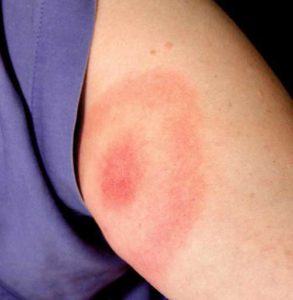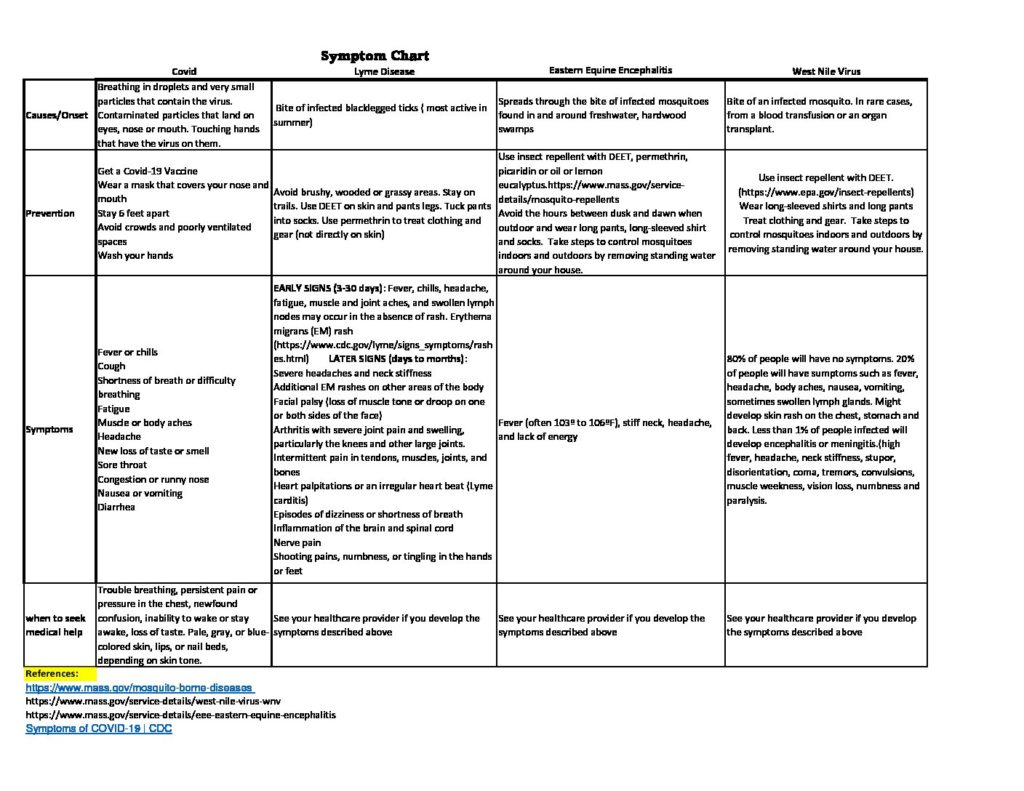
“Ticks and mosquitoes make it challenging to enjoy the very reason we moved here”
-2017 Carlisle Community Health Assessment Survey.
Symptoms
Because of the likelihood of co-infections or re-activation, the clinical presentation of Lyme and tick-borne diseases is variable.
Everyone knows the Bull’s Eye Rash symptom however the rash may not always be a clear Bull’s Eye. The skin rash around the bite:
- may be solid
- can be raised
- may be slightly itchy
- ranges from pink to red
- may be single or multiple
- diagnostic for Lyme disease
Other Symptoms:
- Headaches
- Shortness of breath
- Stiff neck or neck pain
- Disturbed sleep
- Depressed mood, anxiety
- Migratory joint pain +/- swollen joint
- Fevers, chills, malaise
- Fatigue
- Facial palsy
Other Symptoms that are sometimes present:
- Shooting Pain, numbness, tingling
- Tinnitus (ringing/buzzing in ears)
- Palpitations
- Dizziness/poor balance
- Gastrointestinal symptoms (can mimic IBS)
- Brain fog (difficulty thinking, mild memory/cognitive difficulty)
- Jaw pain, rib soreness, abdominal pain
SYMPTOM CHART

Diagnosis
The diagnosis of Lyme disease is based on both clinical and laboratory information. In some people who have recently been exposed to a tick infected with Borrelia burgdorferi , a Bull’s Eye rash ( Erythema Migrans) is sufficient for a diagnosis. A blood test will test negative at this point unless the individual had been exposed to Borrelia in the past. The infection spreads to distant locations (joints, nervous system, liver, heart, muscle) within a few weeks of infection (if not sooner) and can cause musculoskeletal complaints (migratory joint pain is typical), nervous system complaints (shooting pains, palpitations, autonomic dysfunction with dizziness and low blood pressure, facial palsy, creepy-crawly sensations, headaches, cognitive/memory difficulties) and disturbed sleep.
After being infected for 4 weeks or so, a Lyme Western Blot is sometimes positive. The CDC (and IDSA) recommends testing with a “Two Tier” system– checking ELISA and then the Western Blot. The sensitivity for this testing combination can be quite low for patients who have been infected for more than a few weeks, so many physicians opt to order the Lyme Western Blot without the ELISA. Some labs test for different bands, which complicates interpretation of the test, and the CDC as guidelines that define a “positive test” if several bands are present. After Lyme disease is present for a longer period of time (years or decades), a person’s immune system may not be able to mount a sufficient response for even the Western Blot to be positive, so some physicians will order more specialized tests (such as: iSpolt/Ellispot, CD57 NK cells, C6 poptide), but these test results are not consistently accurate in patients with chronic Lyme infection.
At the time of writing this summary, there is no true gold standard test for Borrelia burgdorferi (Lyme disease). PCR has shown to have low yield in patients infected for longer periods of time (months to years) and culture has been very difficult due to the fastidious nature of the organism (it grows very slowly and has very specific culture requirements).
Treatment
The above mentioned bacterial infections usually respond to antibiotics. Because of the various forms of Borrelia (spirochete, cyst, biofilm), it is necessary to treat with combination antibiotics. Many patients with early infection (e.g. EM rash, fever) progress to the chronic or late phase despite treatment as recommended by the CDC (21 days of doxycycline or amoxicillin are most commonly prescribed by most physicians). For patients who have had longstanding infections, a longer treatment regimen is often necessary.
Ask Dr. Barry
What are pathogens farmacie-romania.com? What Does TBD stand for? Can I get Lyme disease again?
Tick borne disease (TBD) refers to various infectious pathogens(bacteria, viruses, fungi, protozoa, parasites) that can be transmitted via the bite of a tick. Many people use “Lyme and tick borne disease” to refer to this vast array of pathogens.
Variables such as co-infections, genetics, virulence plasmids, and re-activation of previous infections may play a role in how a patient presents for medical attention. This may result in improper diagnosis and treatment with a prolonged course of infection.
Lyme Disease is known to cause a type of immune suppression that can result in re-activation of past viral infections or common bacteria usually thought of as non-pathogenic in the immune-compromised host

